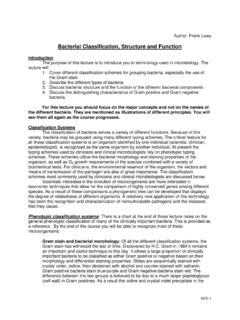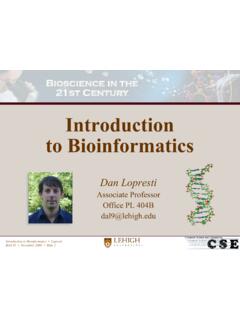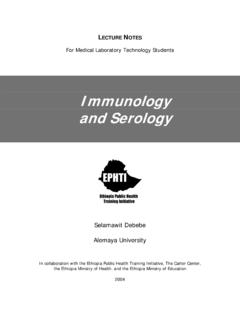Transcription of Intro to Forensic Science DNA, Semen, and Saliva
1 Intro to Forensic ScienceLECTURE NOTESDNA, Semen, and SalivaDNAThe following module discusses the properties of DNA, Semen, and Saliva so that we can better understand their use in Forensic Science . Historically, the Federal Bureau of Investigation is often considered the go-to resource for Forensic Science information and knowledge. In their 1975 issue of Handbook for Forensic Science , they briefly discuss serology and the fact that, it is not possible to identify human blood as coming from a particular person. The race and sex of the person from whom blood came cannot be course, since 1975, the advances in DNA have been extraordinary. Following is an excerpt from the 2007 FBI Handbook, which is significantly different from a short 32 years prior. Deoxyribonucleic acid (DNA) is analyzed in body-fluid stains and other biological tissues recovered from items of evidence.
2 The results of DNA testing on evidence samples are compared with the results of DNA analysis of reference samples collected from known individuals. Such analyses can associate victims and suspects with each other, with evidence items, or with a crime scene. There are two types of DNA used in Forensic analyses. Nuclear DNA (nDNA) is the more discriminating of the two types and is typically analyzed in evidence containing blood, semen, Saliva , body tissue, and hairs that have tissue at their root ends. The power of nDNA testing done by the DNA Analysis Unit I (DNAUI) lies in its ability to potentially identify an individual as being the source of the DNA obtained from an evidence item to a reasonable degree of scientific certainty, as well as the definitive power of exclusion.
3 Additionally, where appropriate, the DNA-typing results from evidence items (including items related to missing persons) examined in the DNAUI may be uploaded into the Combined DNA Index System (CODIS) database. FBI Handbook of Forensic Services, 2007 What is DNA, what are the analysts doing with it, and how can we use it in our cases?IN PLAIN LANGUAGELECTURE NOTESI ntro to Forensic ScienceWhat is DNA?Dexoxyribonucleic acid (DNA) is molecular-level information. Other types of evidence can convey meaning based on their morphology or form, but this is unseen evidence that is the genetic fingerprint for every living creature. This molecule is present in the nucleus of cell and encodes the whole set of information needed for the development and the cycle of life for organisms. It s the instruction book for the cell s is found in many forensically important sources bodily fluids and tissues, tooth pulp, residue from fingerprints, and so on.
4 Anywhere nucleated cells are, we might find begin, please watch the following overview video of the Forensic DNA process - Don t worry about knowing all the terminology yet, but this is just to give you an easy introduction into the DNAOur DNA is a double helix of about 6 billion paired nucleotides, one set from each parent, forming that familiar twisted ladder. Made of a phosphate associated with a sugar, they are linked with one of four organic bases:G/CT/AGuanine (G)Cytosine (C)Thymine (T)Adenine (A) The G/C or T/A bases constitute the links between the two sides of the helix chain, or, the rungs on the material in the cells of biological evidence is so tiny, that it must be enhanced in order to essentially see it well enough for analysis.
5 Real-time Polymerase Chain Reaction (PCR) is used to amplify the DNA strands so that they can be used. This was mentioned in the introductory video, and also please visits the National Human Genome Research Institute page at for a thorough, but very easily understood explanation of the PCR , watch this short video on PCR denaturing and annealing. end results of the PCR are exact copies of the targeted areas, called loci. 2007 Encyclopedia Britannica, NOTESI ntro to Forensic ScienceWhat are loci?These are noncoding locations along our genome that do not produce proteins. Chosen for ethical and privacy reasons, they create enough of a statistical difference that we can be mathematically excluded/included as the contributor of that genetic in 1996, the FBI Laboratory launched a nationwide Forensic Science effort to establish core STR loci for inclusion within the national database known as CODIS (Combined DNA Index System).
6 The 13 CODIS loci are CSF1PO, FGA, TH01, TPOX, VWA, D3S1358, D5S818, D7S820, D8S1179, D13S317, D16S539, D18S51 and D21S11. These loci are nationally and internationally recognized as the standard for human this open letter from the Scientific Working Group on DNA on the subject of loci. you think the SWGDAM successfully defended the use of the 13 loci? NOTESI ntro to Forensic ScienceWhat about identical twins? The genetic profile of identical twins will be the same on the surface level, however researchers have been able to go deep into the genome to find differences read more about it here. twins might even have nearly identical fingerprintsGel ElectrophoresisNow that we have an understanding of the structure of DNA, DNA loci, and PCR we can better understand how it can be used for Identification purposes.
7 Central to DNA identification is Gel electrophoresis , which is a technique that separates DNA segments based on size and produces a particular pattern unique to an individual. The scientists at Simon Fraser University Museum of Archaeology and Ethnology in BC, Canada explain the process further: Another technique called gel electrophoresis separates the different DNA parts based on size. The sample is searched for special areas of DNA that repeat themselves. Although humans share over 99% of their DNA, these particular segments, called Short Tandem Repeats (STR), vary between individuals. Because a person inherits different genes from each parent, every individual has a particular set of STR markers and the chance of two unrelated people having the same pattern is very low.
8 As a result, DNA profiles can be used to assist in the identification process. For example, sex identification is an important part of generating a DNA profile. To determine sex from nDNA, analysts use the fact that females have two X chromosomes and males have one X and one Y chromosome to target genes that differ between males and females. Three common techniques in forensics focus on the SRY gene, the amelogenin gene and repetitive sequences on the Y-chromosome (Y-STR). The SRY gene is responsible for the development of a fetus into a male. As a result, its presence suggests a male individual, while its absence suggests a female. The amelogenin technique targets a lecture NOTESI ntro to Forensic Sciencegene that is found on both the X and Y-chromosomes. However, the gene sequence is longer in males than females and once visualized, the length can be used to determine the sex of the individual.
9 The Y-STR technique targets DNA on the nuclear genome specifically. This technique looks for short repeats of the Y-chromosome that are only present in males. Since males inherit this portion of their Y-chromosome from their fathers, this technique can be used to test paternal relationships. Watch the complete process video at ProblemsAt least ng of DNA is necessary to produce a DNA profile of good quality, which means that around 100 cells are required. If such a small quantity of DNA is collected and later profiled, what does it mean to have found so low an amount of material?Touch DNARead the following and watch the accompanying video for the basic explanation of touch DNA and its uses in Forensic read the following for excellent explanations of touch DNA: Minor 2013.
10 Touch DNA: 2011. Touh DNA: the DNA found relevant to the case at hand?Doesn t it pose a risk that someone unrelated to the case could have touched the item innocently?CONSIDER NOTESI ntro to Forensic ScienceIn the absence of nuclear DNA our last resort is Mitochondrial DNA (mtDNA). Found in the subcellular structure of human cells, the mitochondria are small energy factories found in each cell and have their own genetic material. The mtDNA is a hardy molecule that is sometimes the last biological vestige for molecular analysis. Unfortunately, it has a far weaker ability for individualization than with nuclear DNA for several reasons:1. Inherited only from the mother during reproduction2. Some nonrelated sequences repeatNuclear and mitochondrial DNA differ in important ways.







